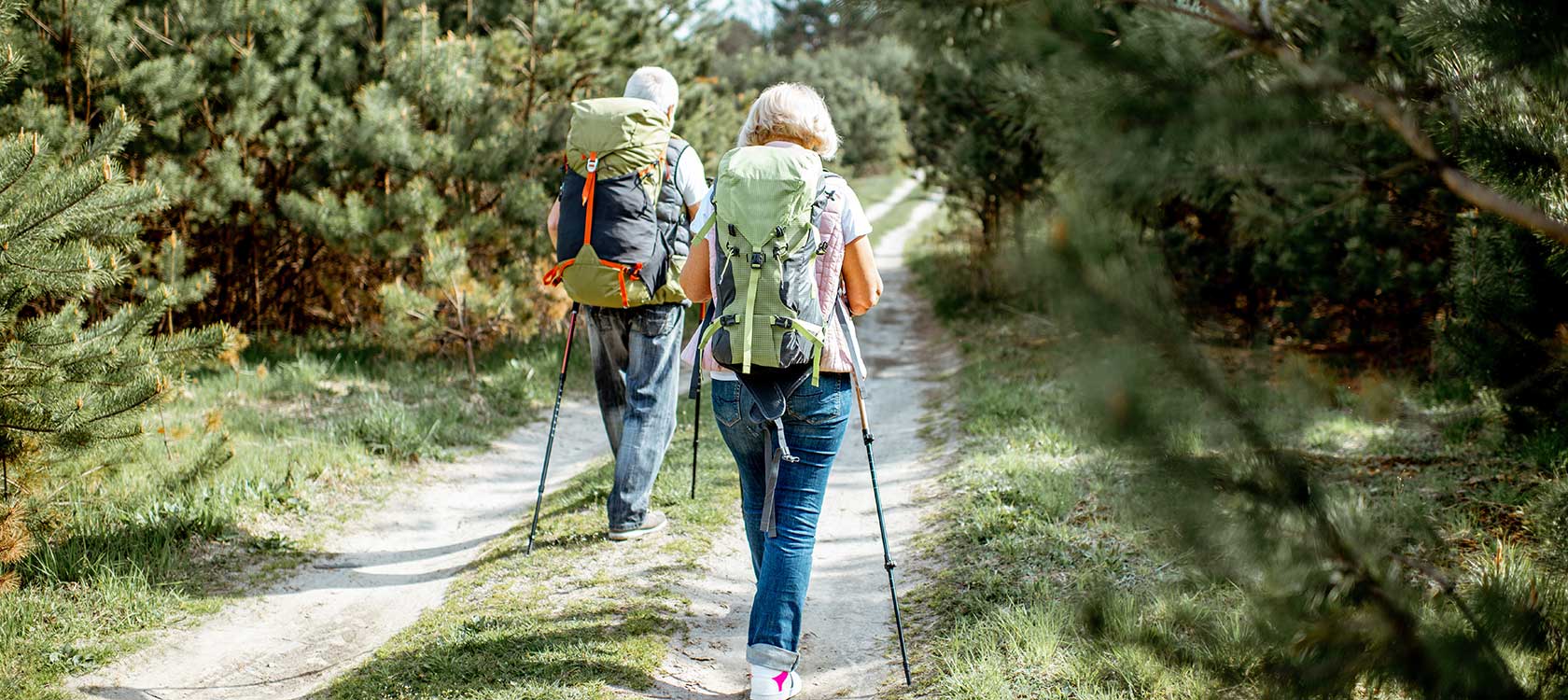
09 Mar Essential Gear Needed for Walking Trails
Posted at 02:12h
in Blog
Humans excel at physical endurance. Our ability to travel for hours on foot may not dazzle speedier mammals like cheetahs or even horses, but 2 million years ago it made us formidably persistent hunters and today it makes us naturals at hiking, even as we get older. But even with our highly developed endurance, the right gear can make hiking more enjoyable — and safer. Here’s a list of hiking gear for seniors that can help you make the most of this invigorating — and health-boosting — hobby.
Why Hike?
Physical activity is linked to numerous health benefits, and hiking is no exception. It boosts life expectancy, improves sleep, supports cardiovascular health, while reducing brain fog and the risk of Type 2 diabetes.
What’s more, hiking offers the therapeutic benefits of being in nature. According to researchers, spending 120 minutes a week in nature improves health and well-being, lowering stress hormone levels, enhancing the immune system, reducing anxiety and improving mood.
Essential Hiking Gear for Seniors
Before you set out for the nearest trailhead, you’ll want to make sure you have the equipment that will help you stay safe and comfortable on your treks. To get properly kitted out, invest in the following:
Suitable Clothing
Hiking enthusiasts claim there’s no bad weather, only inappropriate clothing. To make sure you’re dressed appropriately for your next hike, keep these tips in mind:
- Choose clothing made from materials that move moisture away from the skin and dry quickly. Polyester, nylon and merino wool work better than denim and cotton.
- Dress in layers, including a waterproof outer layer, so you can shed or don clothes to adjust to changing conditions.
- Check the weather forecast, but be prepared for it to be wrong.
- Wear a brimmed hat to keep your head dry and the sun out of your eyes.
- Opt for pants made from sturdy, quick-drying fabrics. Consider convertible, also called zip-off, pants so you don’t have to decide between shorts and long pants.
- Pick socks that come up higher than your footwear.
- Bring gloves or mittens that are insulated and waterproof if temperatures are cold.
Appropriate Footwear
Shopping for hiking boots can be almost as complex as choosing your next vehicle. Boots come in a variety of styles, can be made from many different materials from leather to synthetics to vegan-friendly, and offer various amounts of cushion and support. The best way to find a boot that fits comfortably is to shop in person, so you can try on a pair and walk around in them before you make your decision. You want a boot that’s snug but not tight, while leaving room for you to wiggle your toes. Feet tend to swell as the day progresses, so shop at the end of the day when your feet are larger. And wear the socks you’ll be hiking in.
Sturdy Support
Trekking poles or a walking staff make the list of essential hiking gear for seniors because they support stability and balance as you navigate challenging terrain. To choose the poles or staff that work best for you, consider:
- Length. With a suitably sized pole, you’ll have a 90 degree bend at your elbow when the pole tip touches the ground.
- Terrain. Trekking poles are sold as a pair and can help reduce impact on your knees, especially when you’re walking down hill, making them an ideal choice in hilly terrain. A hiking staff is more suitable on flat trails.
- Features. Do you want your trekking pole to be foldable? Adjustable? To have internal, shock-absorbing springs? You can even get a hiking staff with a camera mount under the handle, so you can use it as a monopod.
The Right Backpack
While the backpack you carried in your school days may have been one-size-fits-all, the pack you use for hiking is more specialized. Selecting the right one will depend on your build, the amount of time you spend on the trail and the cargo you expect to carry. Often called a daypack when it’s used for a one-day outing, the pack you choose should:
- Have water bottle pockets on each side.
- Be the right size for your torso length and hip size.
- Include strong, adjustable chest and hip straps.
- Have compartments or capacity enough for the items you expect to carry, such as a first-aid kit, snacks, extra socks, your phone, map, compass, bug repellent and sunscreen.
Discover an Active Retirement Lifestyle at The Woodlands at Furman
Nestled in the foothills of the Blue Ridge Mountains, The Woodlands at Furman’s proximity to a variety of hiking trails in Greenville, South Carolina, is one of many outstanding features. We’re a university-based retirement community, where lifelong learning, a bustling campus, and an array of services and amenities foster an active retirement lifestyle. Contact us to learn more about our vibrant community, or schedule a tour and experience the rewarding lifestyle for yourself. Contact us to learn more about our vibrant community, or schedule a tour and experience the rewarding lifestyle for yourself.

